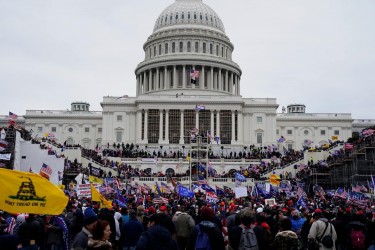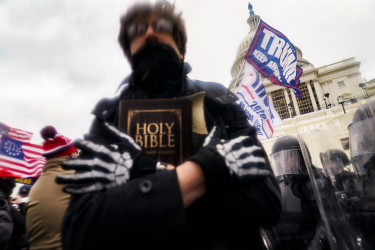Collection
January 6th
The attack on the Capitol in the early days of 2021 shocked the nation. At first, it struck many as not only completely unprecedented, but also unrepresentative of American values. But as historians and others pointed out in the weeks and months that followed, the warning signs had been present, and parallels with past events abounded. This collection gathers a selection of their writing, organized loosely based on analytical approach. Following a selection of "first impressions," we offer a sampling of reflections about historical antecedents, the ways that rioters themselves invoked history, and about the terms that have been used to make sense of the event. Finally, the collection delves into the ways that the riot has registered in American politics and memory in the three years since Jan. 6th, 2021.
FIRST IMPRESSIONS: AMERICAN EXCEPTIONALISM One reason many were surprised, argued journalist Vincent Bevins, is that they bought into the myth that coups only happen in "other" places. This piece debunks that kind of American exceptionalism, while pointing to the very American origins of this particular uprising.
FIRST IMPRESSIONS: CONTINUITY WITH HISTORY As can be seen in this very collection, one photo quickly took on iconic status in media accounts of the riot. This piece offers a deep dive into the different elements in that photo, and asks whether the art on display in the Capitol might actually mirror values projected by the rioters.
CONTESTED FRAMEWORKS: REVOLUTION Some rioters claimed they were fomenting a second American Revolution. This piece argues that the Revolution may have be an antecedent, but not in the way they thought. Instead, it was an instance in which "a small number of highly mobilized people embraced violent direct action on the basis of false beliefs." (Sarah Swedberg suggested another: "blaming powerful political figures or the press for insurrection" <bunkhistory.org/resources/echo-chambers>)
CONTESTED FRAMEWORKS: MIDDLE AGES Some rioters dressed as Vikings and invoked medieval holy war to support their ideas about racial purity, Christian nationalism, and violent masculinity. Here, historian Matthew Gabriele explains the long history of right-wing uses of "pop culture in combination with outdated historiography" to create myths about the Middle Ages.
CONTESTED FRAMEWORKS: RACE & DEMOCRACY Many writers saw the riot as part of a long tradition of backlash to the inclusion of racial and other minorities in the nation's political processes. This piece by journalist Adam Serwer was among the first to explain January 6 as a rejection of multiracial democracy.
LANGUAGE & CONCEPTS: CONSPIRACY THEORIES Blaming conspiratorial thinking on individuals' psychology suggests that debunking misinformation is the cure. Here, Nicolas Guilhot makes the case that conspiracy theories are cultural phenomena with social remedies, and that their root causes "may require a reexamination of our economic and social arrangements."
ANTECEDENTS: LOST CAUSE OF THE CONFEDERACY While Jan. 6 struck many as unprecedented, historians found many events in the nation's past that paralleled at least some parts of the Capitol riot. Here, David Blight suggests that post-Civil War myth-making by white Southerners is a useful framework for understanding the Capitol Riots — and for recognizing how the threat such myths pose to representative government continues to grow.
ANTECEDENTS: FRANCE 1934 Parallels exist outside the U.S. as well. In 1934, a violent mob of right-wing groups and military veterans stormed the French parliament building. Although the attack failed in its immediate aims, it weakened public confidence in France's long tradition of democratic and republican government became mythologized to inspire a growing fascist movement.
JAN 6 AS HISTORY: DOCUMENTS ATTACKERS CREATED Over time, analyses shifted from historical analogizing to attempts to understand Jan. 6 as a historical event in itself. This deep dive into the videos created and shared by rioters themselves asks what these primary sources tell us about participants' motivations and ideologies.
JAN 6 AS HISTORY: CONGRESSIONAL COMMITTEE REPORT Here, Jill Lepore critiques the January 6th Report not on its content, but rather on its style. These sorts of reports, she explains, are intended not only to explain the results of congressional investigations, but also to gain public support and inform policy moving forward. Will this document be up to the task?
FRAMING DEVICE: RACE & INCOME INEQUALITY Watching the coverage of the event, sociologist James R. Jones noted the racial distinctions between the rioters at the Capitol and the janitors who worked there. That observation served as the starting point for this discussion of inequality in Washington, DC.
LOOKING FORWARD: MEMORIALIZATION While the mob violence lasted only a few hours, the ideologies that drove it, and the structures that enabled it, continue to shape the nation's future. Here, historian Louis Nelson reflects on the challenge of remembering January 6th without letting its perpetrators shape our collective memory.
LOOKING FORWARD: POLITICAL ACCOUNTABILITY When the KKK perpetrated a vigilante reign of terror, the federal government responded with strong legislation and a congressional investigation. This piece from two days after the riot calls for a similar approach, warning that otherwise "the silence and inaction of our political leaders will only embolden the white-supremacist mob, undermine democracy and endanger those who have fought" for freedom.
LOOKING FORWARD: ELECTION OF 2024 Immediately after the attack, some scholars began making the case that the 14th Amendment's Section Three, drafted to prevent former Confederates from holding office, makes Trump ineligible to be president again. These arguments were present as Congress weighed impeachment, and have continued as state courts have considered the legality of his future candidacy.
LOOKING FORWARD: ARCHIVES How do the events of January 6th fit into the longer story of American history that archivists and museum curators are preparing to tell at the nation's 250th birthday in 2026? This piece looks at the potential civic and educational impacts of their decisions about what to preserve and display from January 6th.

























